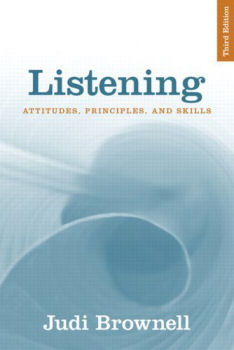
|
Posted December 6, 2005
Book: Listening: Attitudes, Principles, and Skills Author: Judi Brownell Pearson Education, Inc. Boston, 2005, pp. 400 An Excerpt from the Preface:
Listening: Attitudes, Principles and Skills introduces you to the HURIER model, a behavioral approach to listening improvement that serves as a unifying framework for understanding and developing your listening ability. This model suggests that listening is a system of interrelated components that include both mental processes and observable behaviors. The six skill areas, or components, include: hearing, understanding, remembering, interpreting, evaluating, and responding. Listening improvement in each component of the process requires: 1. Appropriate attitudes toward listening – Attitude plays a key role in your ability to listen well. Unless you believe that listening is essential for your personal development, it will be difficult to devote the necessary energy to improving your competence. In addition, effective listening requires an attitude of openness and interest in others. 2. Knowledge of principles about listening — Listening theory and research lends important insight into how your listening can be improved. Key principles guide your efforts as you work to become more effective and more consistent in meeting your listening challenges. 3. Acquisition of fundamental listening skills — Ultimately, the development of appropriate attitudes and the application of listening principles will result in improved performance. The primary goal of this text is to change your behavior — to help you become a better listener. 4. Development of listening strategies — As you will discover, listening requirements vary according to both your purpose and the listening context. Making informed choices about how and when and under what circumstances to apply your listening skills is one of your most important tasks. An Excerpt from the Book: Long-Term Memory Strategies Categorization: Random information can be organized into categories for greater recall. When asked to purchase ten items at a store, you may find organizing information into logical units particularly helpful. Are the items fruits and meat? Snacks? Beverages? Daman could have remembered the entire grocery list without any trouble had he taken time to consciously organize items into several appropriate categories. Tasks, too, can be clustered according to the area in which they take place or the nature of the job – typing, telephoning, scheduling. Mediation Meaningful units of information have a much greater chance of being remembered and recalled than unrelated pieces of data. How can you make sense out of nonsense? Try using one of several mediation techniques. a. Form a meaningful word (or association) out of foreign words or meaningless syllables. Imagine, for example, that you’ve just met Mr. Chabador. By associating the name Chabador with the similar-sounding chair-by-door, you will aid your memory in recall. Anderson, then, would be and-her-son. b. Words can also be made out of the initial letters of items presented. It takes practice to use this technique in your daily encounters. Some instructors, however, do the task for you. Were you taught the lines and spaces in a bar of music by remembering FACE? MADD, Mothers Against Drunk Divers, is another example of how making sense out of items that may first appear random can improve your recall. c. Another mediation technique is to create a word that will link two or more words or ideas that you want to retain. If you need to remember cat, ball, and pillow, you might link them with the word “soft.” This device aids in your recall as you connect the unrelated items in a structured, meaningful way. Table of Contents: 1. Improving Listening Effectiveness 2. Listening Theory and Research 3. The Process of Hearing 4. The Process of Understanding 5. The Process of Remembering 6. The Process of Interpreting 7. The Process of Evaluting 8. The Process of Responding 9. Listening Relationships 10. Listening Challenges |
|
